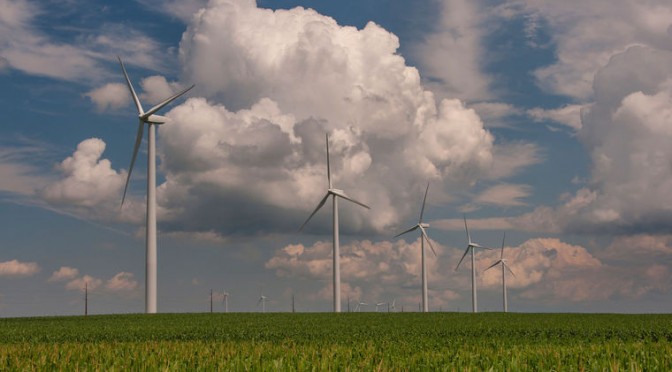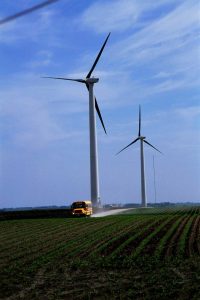All across Iowa, rural communities reside. Driving between those communities, plots of land with hundreds of giant wind turbines are commonly seen from car windows.
These wind turbines provide power to transmission systems and spread around the country, powering communities around America.
But small-scale distributed wind turbines also can power local communities.
In the Department of Electrical and Computer Engineering at Iowa State University, Assistant Professor Zhaoyu Wang (PI), Electric Power and Research Center (EPRC) Director Anne Kimber and Professor Venkataramana Ajjarapu recently received a $1,177,965 grant from the Department of Energy (DOE) for their research on this topic — providing support of the rural power systems through designing optimization models and control algorithms to perfect the connection between windmills and rural, local grids.
“So unlike giant wind farms with hundreds of turbines that deliver power to a transmission system and it goes around the country, our control algorithm could allow windmills to be much more local resources,” Kimber said. “And if we can integrate their operation better, then we can bring up local systems faster.”
In order to enable rural, local utilities to access the windmills around them, the team is creating a control algorithm — or a type of logic that assess data picked up from the farm — that will not only allow local areas to leverage wind farms, but also provide emergency power, in case of a power outage.
“Something very important to farmers is preventing outages,” Wang said. “Sometimes there are power outages, and in rural areas it takes a long time to restore the power and service to the farmers and other customers in rural places. So our idea is using distributed wind turbines to reduce the outage time.”
The team is currently working directly with Algona Municipal Utilities, a small public party utility in north-central Iowa. A distributed wind farm is provided for the team to develop hands-on research — allowing Iowa State to drastically stand out in power research.
“We are the only university in the system integration — setting all the hardware — topic,” Wang said. “We are not only doing research, but also field demonstration.”
Not only is ISU independent and revolutionary in researching this field, but the distributed wind farm they are running with is original and the first of its kind.
“Since this wind farm was the first distributed wind farm in Iowa, we now have all this data from this wind farm — giving us room to make it smarter by optimizing how it operates,” Kimber said.
Wind farms and individual windmills are already having a successful, safe and environmentally clean impact on electricity and power grids. But why not make the process of retaining energy even more successful, safe and clean?
“Right now, a lot of rural areas have generators in the case of a power outage, but they are diesel generators,” Wang said. “Diesel generators are old, dirty and a pollutant. So if we can use this wind and solar energy to replace that, it becomes cleaner.”
With this control algorithm, local windmills will offer direct, clean support in the case of a power outage, with enhanced system reliability and resilience through the distributed wind.
“We are changing the menu of options that the utility can use,” Kimber said. “The wind will become a much more consistent integrated resource into the local utility. We are altering what we already have and making it even better.”
The utility of the smaller, local wind farms will allow people to get more power out of the wind turbines, and it’s one of the cheapest resources because wind has no fuel cost; it’s free.
“If there is an ice storm, you could have an outage that could last a long time because you have rural systems that are not easy to access and they could be damaged, making it hard to repair,” Kimber said. “And not only that, but it could be expensive to repair.”
By having these smaller, local wind farms, the small communities around Iowa could have cleaner, more efficient and more resilient energy.
news.engineering.iastate.edu




